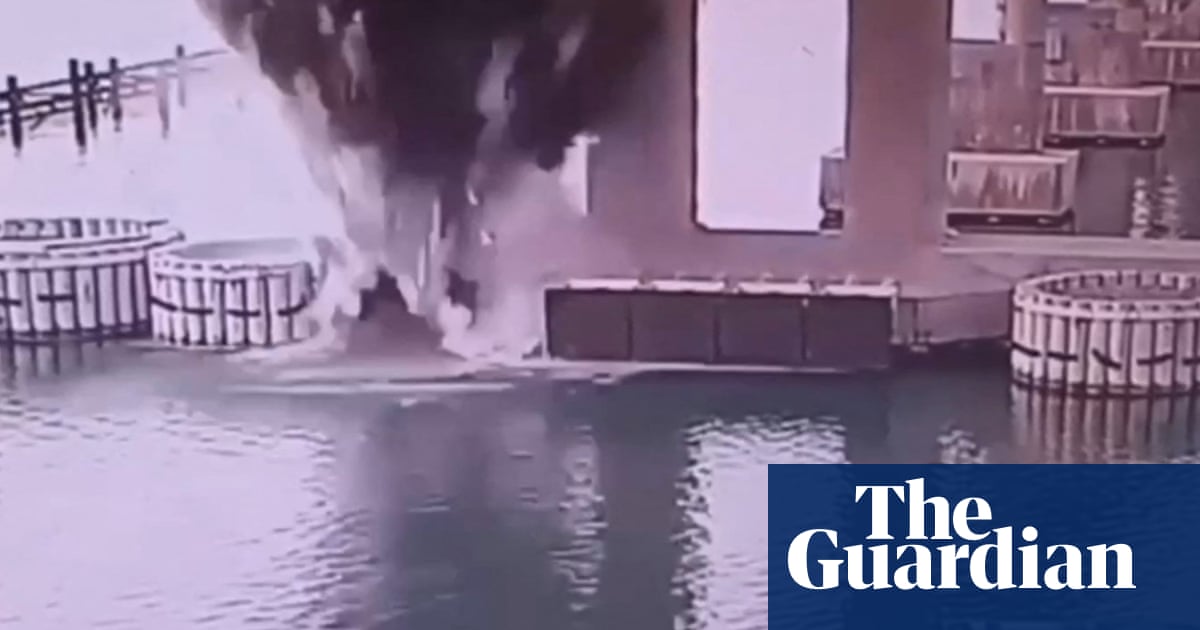Ukraine has detonated a massive underwater blast targeting the key road and rail bridge connecting the Russian-occupied Crimean peninsula to Russia, damaging its underwater pillars.
The operation, claimed by Kyiv’s SBU security service, is the second high-profile operation by Ukraine in days striking significant Russian assets after a sophisticated drone raid on Moscow’s strategic bomber fleet on Sunday.
The attack came as Ukraine confirmed it had been invited to the Nato summit later this month, after President Volodymyr Zelenskyy warned it would be a “victory” for Russia if it was not present.
The latest strike on the 12-mile-long Kerch Bridge – a prestige project of the Russian president, Vladimir Putin, which he opened in 2018 – comes amid what appear to be determined efforts by Ukraine to change the narrative promoted by the Trump administration that Kyiv holds few cards in the war.
The mining of the bridge, which is heavily defended by Russian forces, follows the audacious long-range drone attackon airbases deep in side Russia, which Zelenskyy claimed had damaged “34% of [Russia’s] strategic cruise missile carriers”.
According to a statement from the SBU the operation against the bridge – the third in a series of strikes amid at disabling the key logistics route – had been planned for several months and involved the equivalent of more than a metric tonne of TNT, which it said had “severely damaged” the base of the bridge supports.
It is the third time that Ukraine has targeted the bridge since Moscow’s full-scale invasion in 2022.
In October 2022, a truck exploded on the bridge, while in July 2023, the SBU said it had blown up a part of the bridge using an experimental naval drone. Both times, Russia repaired the damaged sections.
Lt Gen Vasyl Maliuk of the SBU, who supervised the latest operation, described the bridge as “an absolutely legitimate target, especially considering that the enemy used it as a logistical artery to supply its troops”.
He added: “Crimea is Ukraine, and any manifestations of occupation will receive our tough response.”
TheSBU published footageshowing a blast coming out of the water and debris flying, along with a photo of some damage to the side of the bridge.
Road traffic on the bridge linking Russia and the Crimean peninsula had been temporarily suspended, Russian authorities said on Telegram on Tuesday. Russian state media reported it had been closed to traffic for about four hours.
The attack on the bridge came as Russia said on Tuesday said it was wrong to expect a quick breakthrough in Ukraine talks, a day after Moscow rejected Kyiv’s call for an unconditional ceasefire at negotiations in Istanbul – more than three years into Russia’s offensive that has killed tens of thousands on both sides and forced millions from their homes in eastern Ukraine.
The sidesagreed on a large-scale swap of captured soldiersand exchanged their roadmaps to peace, or so-called “memorandums”, at the discussions, which lasted under two hours.
“The settlement issue is extremely complex and involves a large number of nuances,” the Kremlin’s spokesperson, Dmitry Peskov, told reporters on Tuesday. “It would be wrong to expect immediate solutions and breakthroughs.”
Peskov was speaking as Andriy Yermak, Zelenskyy’s chief of staff, arrived in the US along with the deputy prime minister Yulia Svrydenko to press for tougher sanctions on Russia.
“We plan to talk about defence support and the situation on the battlefield, strengthening sanctions against Russia,” Yermak said on Telegram.
Moscow is demanding Ukraine pull its troops out of four eastern and southern regions that Moscow claims to have annexed, as a precondition to pausing its offensive, according to the document handed to the Ukrainians that was published by Russian state media.
Kyiv had pressed for a full and unconditional ceasefire. Russia instead offered a partial truce of two to three days in some areas of the frontline, its top negotiator said after the talks.
Peskov also dismissed the idea of a summit between the presidents of Russia, Ukraine and the US.
“In the near future, it is unlikely,” he told reporters, adding that such a summit could happen only after Russian and Ukrainian negotiators reached an “agreement”.
The White House had said on Monday that the US president, Donald Trump, was “open” to the idea, which is also backed by Zelenskyy and by Turkey’s president, Recep Tayyip Erdoğan.
Zelenskyy’s attendance at the Nato summit in The Hague from 24 to 26 June was welcomed by the Ukrainian president after reported misgivings over the potential for the renewal of friction between Zelenskyy and Trump administration officials.
“We were invited to the Nato summit. I think this is important,” Zelenskyy said on Monday after he held a meeting with Nato’s secretary general, Mark Rutte, in Vilnius.
Agencies contributed to this report
